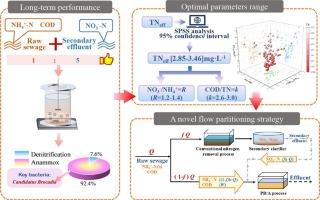Flow partitioning strategy for partial denitrification and anammox (PD/A) implementation: simultaneous treatment of raw sewage and secondary effluent in WWTPs
IF 6.7
2区 工程技术
Q1 ENGINEERING, CHEMICAL
引用次数: 0
Abstract
The Partial Denitrification/Anammox (PD/A) process is an environmentally friendly approach to remove nitrogen, but its implementation in wastewater treatment plants (WWTPs) presents significant challenges, primarily due to the complexity and fluctuation of actual sewage. In this study, an integrated fixed-film activated sludge (IFAS) coupled with PD/A process (IFAS-PD/A) was developed to simultaneously treat raw sewage and secondary effluent from the 9th WWTP in Xi'an. The preliminary batch tests identified an optimal mixing ratio of 1:5, with corresponding NO3−/NH4+ and COD/TN ratios of 1.24 and 2.54, respectively. This mixing ratio was subsequently applied in a 90 days long-term operation. The IFAS-PD/A system demonstrated stable nitrogen removal performance, achieving an effluent total nitrogen concentration (TNeff) of 3.16 ± 0.92 mg·L−1 with 85.14 ± 2.24 % removal efficiency. Microbial community analysis showed that the IFAS-PD/A system was dominated by heterotrophic denitrifiers (Saprospiraceae and Thauera) and Candidatus Brocadia. SPSS statistical analysis indicated that when TNeff value was 2.85–3.46 mg·L−1 (95 % confidence interval), the corresponding influent NO3−/NH4+ and COD/TN ratios were 1.2–1.4 and 2.6–3.0, respectively. Based on these results, a specific flow partitioning strategy for the application of the PD/A process in WWTPs was proposed. The strategy provid a novel insight into the practical application of the PD/A process to achieve a more efficient and energy-saving nitrogen removal in real WWTPs.

部分反硝化和厌氧氨氧化(PD/A)实施的流量分配策略:污水处理厂原水和二次出水的同时处理
部分反硝化/厌氧氨氧化(PD/A)工艺是一种环保的脱氮方法,但在污水处理厂(WWTPs)中实施该工艺面临着重大挑战,主要原因是实际污水的复杂性和波动性。本研究采用固定式膜活性污泥(IFAS)耦合PD/A工艺(IFAS-PD/A)同时处理西安市第九污水处理厂原污水和二级出水。初步批量试验确定最佳配比为1:5,NO3−/NH4+和COD/TN比值分别为1.24和2.54。该混合比例随后应用于90天的长期运行。IFAS-PD/A系统具有稳定的脱氮性能,出水总氮浓度(TNeff)为3.16±0.92 mg·L−1,去除率为85.14±2.24%。微生物群落分析表明,IFAS-PD/A系统以异养反硝化菌(Saprospiraceae和Thauera)和Candidatus Brocadia为主。SPSS统计分析表明,当TNeff值为2.85 ~ 3.46 mg·L−1(95%置信区间)时,相应的进水NO3−/NH4+和COD/TN比值分别为1.2 ~ 1.4和2.6 ~ 3.0。在此基础上,提出了一种特定的PD/ a流程在污水处理厂应用的流程划分策略。该策略为PD/ a工艺的实际应用提供了新的见解,从而在实际污水处理厂中实现更高效、更节能的脱氮。
本文章由计算机程序翻译,如有差异,请以英文原文为准。
求助全文
约1分钟内获得全文
求助全文
来源期刊

Journal of water process engineering
Biochemistry, Genetics and Molecular Biology-Biotechnology
CiteScore
10.70
自引率
8.60%
发文量
846
审稿时长
24 days
期刊介绍:
The Journal of Water Process Engineering aims to publish refereed, high-quality research papers with significant novelty and impact in all areas of the engineering of water and wastewater processing . Papers on advanced and novel treatment processes and technologies are particularly welcome. The Journal considers papers in areas such as nanotechnology and biotechnology applications in water, novel oxidation and separation processes, membrane processes (except those for desalination) , catalytic processes for the removal of water contaminants, sustainable processes, water reuse and recycling, water use and wastewater minimization, integrated/hybrid technology, process modeling of water treatment and novel treatment processes. Submissions on the subject of adsorbents, including standard measurements of adsorption kinetics and equilibrium will only be considered if there is a genuine case for novelty and contribution, for example highly novel, sustainable adsorbents and their use: papers on activated carbon-type materials derived from natural matter, or surfactant-modified clays and related minerals, would not fulfil this criterion. The Journal particularly welcomes contributions involving environmentally, economically and socially sustainable technology for water treatment, including those which are energy-efficient, with minimal or no chemical consumption, and capable of water recycling and reuse that minimizes the direct disposal of wastewater to the aquatic environment. Papers that describe novel ideas for solving issues related to water quality and availability are also welcome, as are those that show the transfer of techniques from other disciplines. The Journal will consider papers dealing with processes for various water matrices including drinking water (except desalination), domestic, urban and industrial wastewaters, in addition to their residues. It is expected that the journal will be of particular relevance to chemical and process engineers working in the field. The Journal welcomes Full Text papers, Short Communications, State-of-the-Art Reviews and Letters to Editors and Case Studies
 求助内容:
求助内容: 应助结果提醒方式:
应助结果提醒方式:


